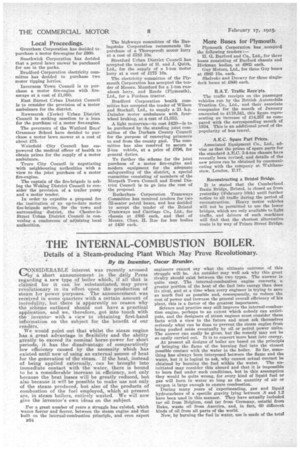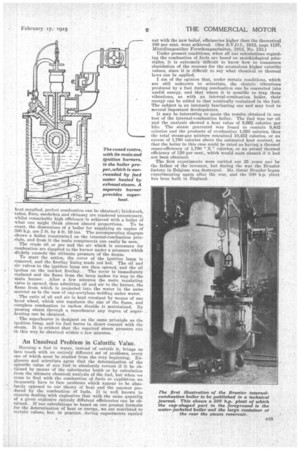THE INTERNAL-COMBUSTION BOILER.
Page 8

Page 9

If you've noticed an error in this article please click here to report it so we can fix it.
Details of a Steam-producing Plant Which May Prove Revolutionary. By its Inventor, Oscar Brunler.
CONSIDERABLE interest was recently aroused
a short announcement in dm daily Press regarding a new type of boiler which; if all that is claimed for it can be—substantiated, may prove revolutionary in its effect upon the production of steam for power purposes. The announcement was received in some quarters with a certain amount of incredulity, but.there is apparently no reason why the scheme outlined should not have a practical application, and we, therefore, _got into touch with thb invento7 with a view to obtaining first-hand information on the subject for the benefit of our readers.
We would point out that whilst the steam engine has a great advantage in flexibility and the ability greatly to exceed its nominal horse-power for short periods, it has the disadvantage of comparatively low ellicieney caused by the necessity which has existed until now of using an external source of heat for the generation of the steam. If the heat, instead of being applied externally, can be brought into immediate contact with-the water, there is bound to be a considerable increase in efficiency,, not only because the heat losses will be greatly reduced, but also because it will be possible to make use not only of the steam. produced, but also of the products Of combustion of the fuel employed, which at present are, in steam boilers, entirely wasted. We will now give the inventor's own ideas on the subject.
• For a great number of years a struggle has existed, which waxes fiercer and fiercer, between the 'steamengine and that built on the internal-combustion principle, and even expert
B24 engineers cannot say what the ultimate outcome of this struggle will be. An outsider may well ask why this great rivalry should exist between the two types. The answer is quite easy. The internal-combustion engine converts a greater portion of the heat of the fuel into energy than does its rival, and at a time when every engineer is trying to save as much fuel as possible and, consequently, to reduce the cost of power and increase the general overall efficiency of his plant, this is a factor of the greatest importance. Science and practice may still improve the internal-combustion engine, perhaps to an extent which nobody can anticipate, and the designers of steam engines must consider these facts with a view to the future and must ask themselves seriously what can be done to prevent the steam engine from being pushed aside eventually by oil or petrol power units. The answer can easily be given, but the remedy may not be so easily carried out. It is to convert more heat into energy.
At present all designs of boiler are based on the principles of bringing the flame of the burning fuel into the closest passible contact with the water in the boiler. So far, something has always been interposed between the flame and the water, hut it is logical to ask, why cannot actual contact be obtained by burning the fuel within the water. The uninitiated may consider this absurd and that it is impossible to burn fuel under sue.h conditions, but in this assumption they would be quite wrong, for every kind of liquid fuel or gas will burn in water so long as the quantity of air or oxygen is large enough to ensure combustion.
During many years of experimenting, gas and liquid hydrocarbons of a specific gravity lying between .8 and 1.2 have been used in this manner. They have actually included tar oil from Belgium, coal tar from Germany, ostatki from Baku, waste oil from America, and, in fact, 60 different kinds of oil from all parts of the world.
Now, by burning the fuel in water, use is made of the total
heat supplied, perfect combustion can be obtained-; brickwork, tubes, flues, smokebox and chimney are rendered unnecessary, whilst remarkably high efficiency-is achieved with a boiler of what one might think almost absurd proportions. To be exact, the dimensions of a boiler for supplying an engine of 500 h.p. are 3 ft. by 4 ft. 10 ins. The accompanying diagram shows a boiler constructed on the internal-combustion principle, and from it the main components can easily be seen.
The crude oil or gas and the air which is necessary for combustion are supplied to the burner under a pressure which slightly exceeds the ultimate •pressure of the steam.
To start the action, the cover of the ignition lamp is removed, and the fireelay lining made red hot. The oil and air valvesto the ignition Imp are then opened, and the oil ignites on the red-hot fireclay. The cover is immediately replaced and the flame from the lamp makes its way tO the main burner. After a few minutes the main regulating valve is opened, thus admitting oil and air to the burner, the flame from Which is projected into the water in the same manner as in the case of oxy-acetylene welding under water.
The ratio of oil and air is kept constant by means of one hand wheel, which also regulates the size of the flame, and complete combustion to carbon dioxide is maintained. By passing steam through a superheater any degree of 'superheating can be obtained.
The superheater is designed on the same principle as the ignition lamp, and its fuel burns in direct contact with the steam. It is evident that the required steam pressure can in this way be obtained within -a few minutes.
An Unsolved Problem in Calorific Value.
Burning a fuel in water, instead of outside it, brings us into touch with an entirely different set' of problems, every one of which must be studied from the very beginning. Engineers and scientists agree that the determination of the calorific value of any fuel is absolutely correct if it be obtained by means of the calorimeter bomb or by calculation from the ultimate chemical analysis of the fuel, but when we come to 'deal with the combustion of fuels or explosives we frequently have to face problems which appear to be absolutely opposed to our theory of heat and the amount produced by the combustion of fuels. It is well known to experts dealing with explosives that with the same quantity of a given explosive entirely different efficiencies can be obtained. If our calculations be based on our present formula, for the determination of heat or energy, we are restricted to certain values, but in practice, during experiments carried
out with the new boiler, efficiencies higher than the theoretical 100 per cent. were achieved. (See Z.V.D.1., 1912, page 1157. Mitteilungeniiber Forschongsarbeiten, 1913, No. 133.)
Under present conditions, when all our calculations regarding the combustion of .fuels are based on stoichiological principles, it is extremely difficult to know how to commence elucidation of the reasons for the anomalous higher calorific values, since it is difficult to say what chemical or thermal laws can be applied.
I am of the opinion that, under certain conditions, which are still unknown to scientists, the electric vibrations produced by a fuel during combustion can be converted into useful energy, and that where it is possible to trap these vibrations, as with an internal-combustion boiler, their energy can be added to that nominally contained in the fuel. The subject is an intensely fascinating one and may lead to several important developments.
It may be interesting to quote the results obtained in one test of the internal-combustion boiler. The fuel was tar oil and the analysis showed a heat value of 8,662 calories per kilo. The steam generated was found to contain 9,402 calories and the products of combustion 1,050 calories, thus the total steam-gas mixture contained 10,452 calories, or an excess of 1,790 calories above the estimated heat content, so that the boiler in this case could be rated as having a thermal super-efficiency of 1,790 " X " calories, or an actual thermal efficiency of 120 per cent., which would seem absurd if it had not been obtained.
The first experiments were carried out 35 years ap.,.O by the father of the inventor, but during the war the Brunler factory in Belgium was destroyed. Mr. Oscar Brunler began experimenting again after the war, and the 500 h.p. plant has been built in England.
































